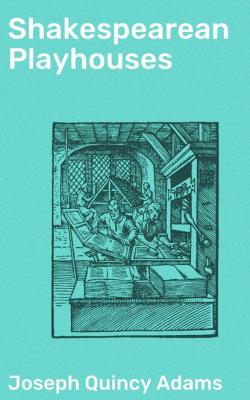ТОП просматриваемых книг сайта:
Shakespearean Playhouses. Joseph Quincy Adams
Читать онлайн.Название Shakespearean Playhouses
Год выпуска 0
isbn 4057664655325
Автор произведения Joseph Quincy Adams
Жанр Документальная литература
Издательство Bookwire
The French Players’ Temporary Theatre in Drury Lane
Davenant’s Projected Theatre in Fleet Street
A HISTORY OF ENGLISH
THEATRES from the BEGINNINGS to the RESTORATION
By JOSEPH QUINCY ADAMS
Cornell University
Gloucester, Mass.
PETER SMITH
1960
COPYRIGHT, 1917, BY
JOSEPH QUINCY ADAMS
REPRINTED, 1960,
BY PERMISSION OF
HOUGHTON MIFFLIN CO.
MAP OF LONDON SHOWING THE PLAYHOUSES
[Enlarge]
Blackfriars, (first) 1576–1584.
Blackfriars, (second) 1596–1655.
Curtain, 1577-after 1627.
Fortune, (first) 1600–1621.
Fortune, (second) 1623–1661.
Globe, (first) 1599–1613.
Globe, (second) 1614–1645.
Hope, 1613-after 1682.
Phoenix or Cockpit, 1617-after 1664.
Red Bull, about 1605-after 1663.
Rose, 1587–1605.
Salisbury Court, 1629–1666.
Swan, 1595-after 1632.
Theatre, 1576–1598.
Whitefriars, about 1605–1614(?).
TO
LANE COOPER
IN GRATITUDE AND ESTEEM
PREFACE
THE method of dramatic representation in the time of Shakespeare has long received close study. Among those who have more recently devoted their energies to the subject may be mentioned W.J. Lawrence, T.S. Graves, G.F. Reynolds, V.E. Albright, A.H. Thorndike, and B. Neuendorff, each of whom has embodied the results of his investigations in one or more noteworthy volumes. But the history of the playhouses themselves, a topic equally important, has not hitherto been attempted. If we omit the brief notices of the theatres in Edmond Malone's The Plays and Poems of William Shakespeare (1790) and John Payne Collier's The History of English Dramatic Poetry (1831), the sole book dealing even in part with the topic is T.F. Ordish's The Early London Theatres in the Fields. This book, however, though good for its time, was written a quarter of a century ago, before most of the documents relating to early theatrical history were discovered, and it discusses only six playhouses. The present volume takes advantage of all the materials made available by the industry of later scholars, and records the history of seventeen regular, and five temporary or projected, theatres. The book is throughout the result of a first-hand examination of original sources, and represents an independent interpretation of the historical evidences. As a consequence of this, as well as of a comparison (now for the first time possible) of the detailed records of the several playhouses, many conclusions long held by scholars have been set aside. I have made no systematic attempt to point out the cases in which I depart from previously accepted opinions, for the scholar will discover them for himself; but I believe I have never thus departed without being aware of it, and without having carefully weighed the entire evidence. Sometimes the evidence has been too voluminous or complex for detailed presentation; in these instances I have had to content myself with reference by footnotes to the more significant documents bearing on the point.
In a task involving so many details I cannot hope to have escaped errors—errors due not only to oversight, but also to the limitations of my knowledge or to mistaken interpretation. For such I can offer no excuse, though I may request from my readers the same degree of tolerance which I have tried to show other laborers in the field. In reproducing old documents I have as a rule modernized the spelling and the punctuation, for in a work of this character there seems to be no advantage in preserving the accidents and perversities of early scribes and printers. I have also consistently altered the dates when the Old Style conflicted with our present usage.
I desire especially to record my indebtedness to the researches of Professor C.W. Wallace, the extent of whose services to the study of the Tudor-Stuart drama has not yet been generally realized, and has sometimes been grudgingly acknowledged; and to the labors of Mr. E.K. Chambers and Mr. W.W. Greg, who, in the Collections of The Malone Society, and elsewhere, have rendered accessible a wealth of important material dealing with the early history of the stage.
Finally, I desire to express my gratitude to Mr. Hamilton Bell and the editor of The Architectural Record for permission to reproduce the illustration and description of Inigo Jones's plan of the Cockpit; to the Governors of Dulwich College for permission to reproduce three portraits from the Dulwich Picture Gallery, one of which, that of Joan Alleyn, has not previously been reproduced; to Mr. C.W. Redwood, formerly technical artist at Cornell University, for expert assistance in making the large map of London showing the sites of the playhouses, and for other help generously rendered; and to my colleagues, Professor Lane Cooper and Professor Clark S. Northup, for their kindness in reading the proofs.
Joseph Quincy Adams
Ithaca, New York
ILLUSTRATIONS

